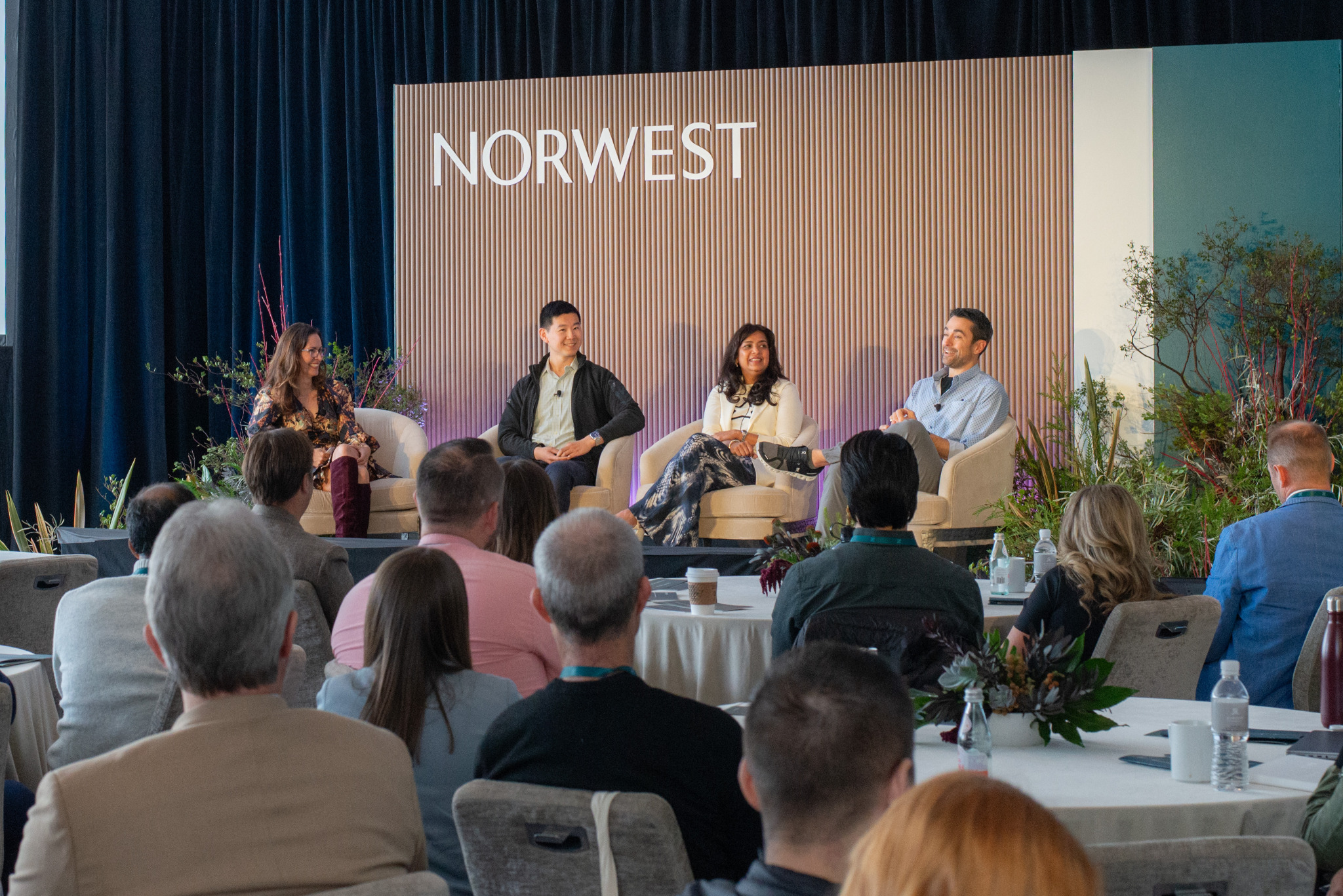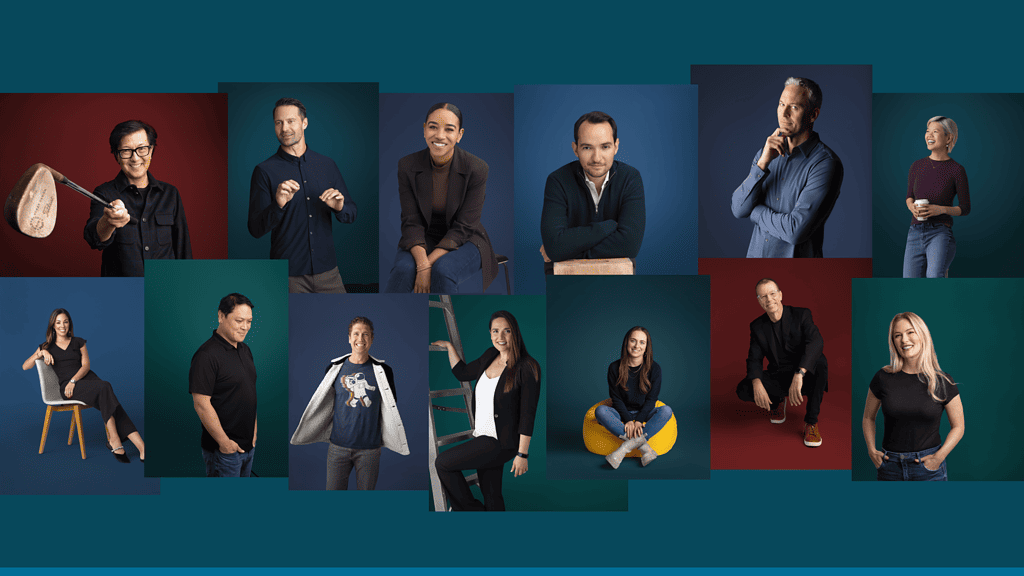The Norwest Growth Marketing Summit made a triumphant return this year, uniting B2B, B2C, and healthcare portfolio marketing leaders and friends.
The timing couldn’t be better — with 2024 planning underway, we gathered our community in a safe space for inspiration, learning, and frank conversations about common challenges.
I started the day rallying our attendees around three actions for the day, and every day:
- Aspire to change at least one behavior based on what you learn today
- Instill more wonder and rigor into your work (our keynote speaker Natalie Nixon touches on this in her book, “The Creativity Leap”)
- Lead with humility and courage in a more expansive way than you’re already doing
Each speaker brought their most authentic, vulnerable selves forward during their presentations in service of helping others be better. Some of our attendees called the conference a goldmine of marketing information and in this recap I’m delighted to surface the best insights from the content shared, starting with the keynote session, followed by the B2B and B2C tracks.
1. Work and Think Like a Jazz Band (Not a Symphony Orchestra)
To optimize creativity, consider functioning like a jazz band — embracing both orchestration and improvisation. Acknowledge that work doesn’t always need to resemble a finely tuned orchestra; instead, allow for flexibility and spontaneity, thinking and acting like a jazz musician. Balance chaos and order, using constraints to drive creativity; this way of thinking is particularly relevant in today’s market.
This perspective from Creative Strategist Natalie Nixon, our keynote speaker, was the perfect note to start our day on. I highly recommend picking up a copy of her book The Creativity Leap: Unleash Curiosity, Improvisation, and Intuition at Work.
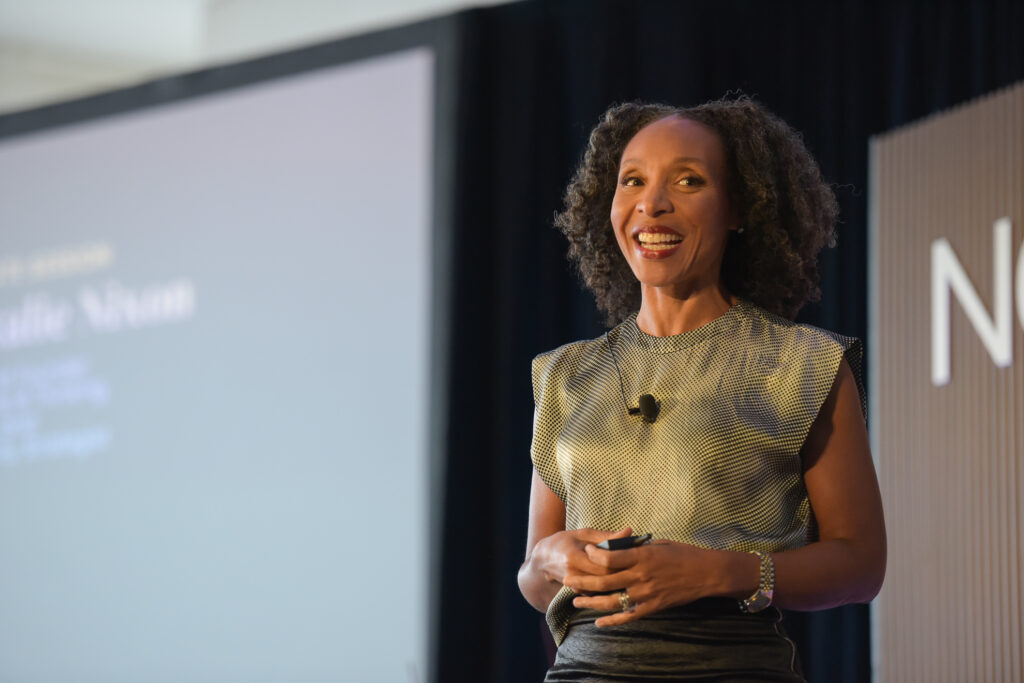
2. Presenting to Your Board of Directors? Stay Strategic and Remember They’re People, Too.
Our partners sit on a number of boards — and they can tell you exactly what an effective board presentation from a CMO looks like. During our ‘How to Gain the Trust of Your Board’ panel, Norwest partners Ran Ding, Priti Youssef Choksi, and Parker Barrile shared their insight.
Arrive with a well-prepared plan, along with the background and data to defend your point of view, and be sure to highlight the outcomes that you expect your plan to drive. Don’t be afraid to lean in to their experience for guidance; your board members can provide insight into what other companies in their portfolio are doing to drive success. Remember, you’re on the same team and they want you to be successful, so let’s reframe board meetings from a one-way reporting session to a two-way exchange of value.
For sharing data, it’s critical to have consistent key performance indicators (KPIs). Rather than selectively showcasing favorable metrics that fluctuate each quarter, stick to a set of reliable north star KPIs. This steadfastness will go a long way in fostering trust and credibility with the board.
“The thing that kills your confidence as a board member is when someone changes their story all the time. Consistency is important.”
– Priti Youssef Choksi, Partner, Norwest
3. Look to Benchmarks to Evaluate Your Marketing Investments
Evaluating your marketing spend against benchmarks can be a useful exercise to see how effectively you wield your budget compared to your peers. And while it’s helpful to know how other marketers are approaching their investments and program priorities, you don’t always have to play it by the book. Stand ready to staunchly defend a different approach if conventional methods fail to align with your strategy or prove futile.
Norwest Marketing Operating Executive Renée Cohen gave a sneak peek into our 2023 B2B Marketing & Sales Benchmark Survey results during her panel. Here’s a quick look at some of the data we collected on marketing tech stacks (full results coming soon!).
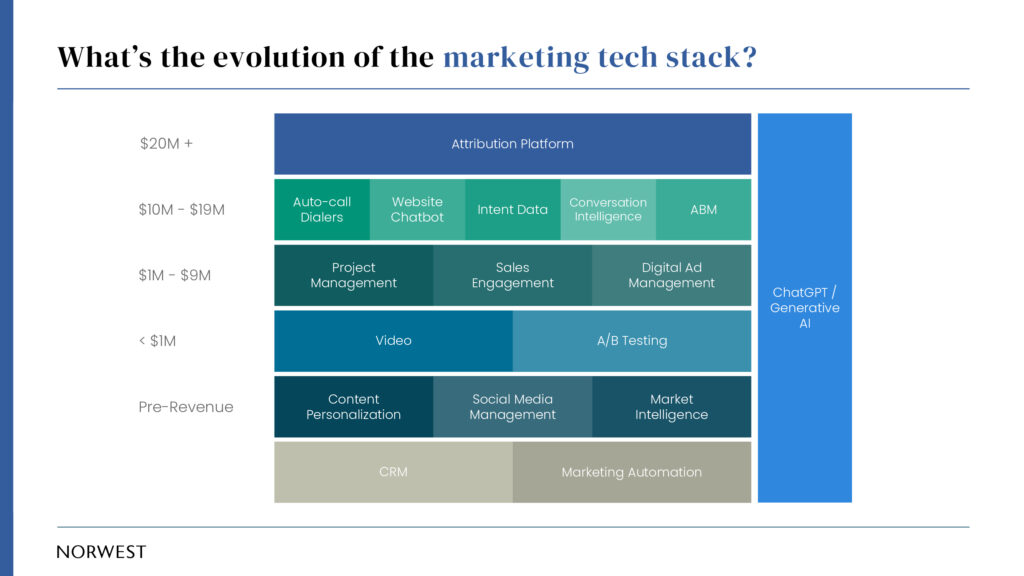
If you’ve spent most of your marketing career at mid- to late-stage companies, you might be used to having more tools, tech, and resources available to you. Here’s the thing: tech doesn’t solve your problems if you don’t have a sound strategy and resourcing plan. You don’t want to over-invest in your tech stack if you haven’t validated the value of your programs. Tech is best used to scale your initiative after you have a proof of concept.
4. Attribution to One Source Will Always Be Misleading
Ditch the tunnel vision when it comes to attribution. Pinning success or failure on a single source oversimplifies the marketing journey. Embrace the complexity, understanding that it’s an intricate dance of interconnected touchpoints.
“The best strategy we have is to work off of benchmarks. You still want to measure the impact of individual touches, but that’s different than attributing a won deal to one thing.”
– Jon Miller, CMO, Demandbase
In Jon’s session, “Mastering the New Playbook for Account-Based Marketing,” he said the biggest problem with the traditional playbook is that it under-invests in brand. Simply put: when a brand is strong, everything else becomes easier.
He also shared his framework for the new ABM playbook, which I’ve detailed in a previous blog, How to Fast Track Your Path to ABM Maturity.
5. Dark Social Is a Stealthy Ally in Creating Super Fans
When someone says ‘dark social’ they’re often referring to links shared via messaging apps, email, or other private communication platforms where referrals aren’t explicitly tagged. Even though dark social might be hard to track, it can be a breeding ground for strong brand advocates. Harnessing the power of one-on-one shares can extend your brand’s visibility, even if it’s hard to quantify. Good content — not just marketing content — is powerful in dark social because it’s relatable or it provides a clear solution in an otherwise unexpected channel.
Looking for inspiration? Check out:
- Lavender Co-founder Todd Clouser’s Video Content Program
- Qualified’s Pipeline Visionaries Podcast, started by CMO Maura Rivera
- SourceDay CMO Sarah Scudder’s LinkedIn Live Series
6. B2B Marketers, Hug Your Sales Leaders More
Yes, harmonizing your organization’s sales and marketing efforts requires effective collaboration, but it won’t last if you don’t have each other’s backs. This piece of advice shined through Spiff CMO’s Anna Fisher’s session.
As with any good relationship, you need to “marry” clear communication with shared goals around pipeline creation. When everyone has skin in the same game, they’re incentivized to work together — to win together. Beyond goals, sales and marketing need to be aligned on campaigns, process, and the data. Getting there might be tough, but worth the payout in the end.

7. Predict Pipeline Better With the Failsafe Waterfall Method
The failsafe waterfall method helps organizations better predict pipeline by combining empirical data with a strategic framework. It anchors your model to a clear bookings plan, establishing it as the cornerstone for all subsequent stages.
Nani Shaffer, CMO at Channel99, shared in-depth worksheets for getting started during her session. Leveraging the power of historical pipeline data and close rates shapes and refines your tailored waterfall model strategically. This meticulous approach culminates in setting actionable pipeline goals, ensuring a harmonized integration of data-backed insights and a comprehensive understanding of your sales process.
“You’ll likely need multiple waterfalls, but too much granularity puts you at risk of too small numbers. Don’t be afraid to adjust numbers manually.”
– Nani Shaffer, CMO, Channel99
8. Brand Is Everyone’s Responsibility, Not Just Marketing
Marketing cannot create a brand. Creating a brand is a commitment that starts with the CEO and trickles down to every last person in the company. It’s everyone’s job, not just marketing. At best, marketing is just the steward of your company’s brand identity.
That’s what Gong Chief Evangelist Udi Ledergor made clear during his session on Building an Iconic B2B Brand. In the early days, the Gong marketing team gathered everyone at the company and came up with a set of principles to guide the culture. Those principles then helped set the brand direction on a path that was authentic to the business and that each person at the company could uphold. Gong’s scrappy roots and strong vision even led Udi to unconventional advertising tactics for a B2B company: two Super Bowl ads and a billboard in Times Square.
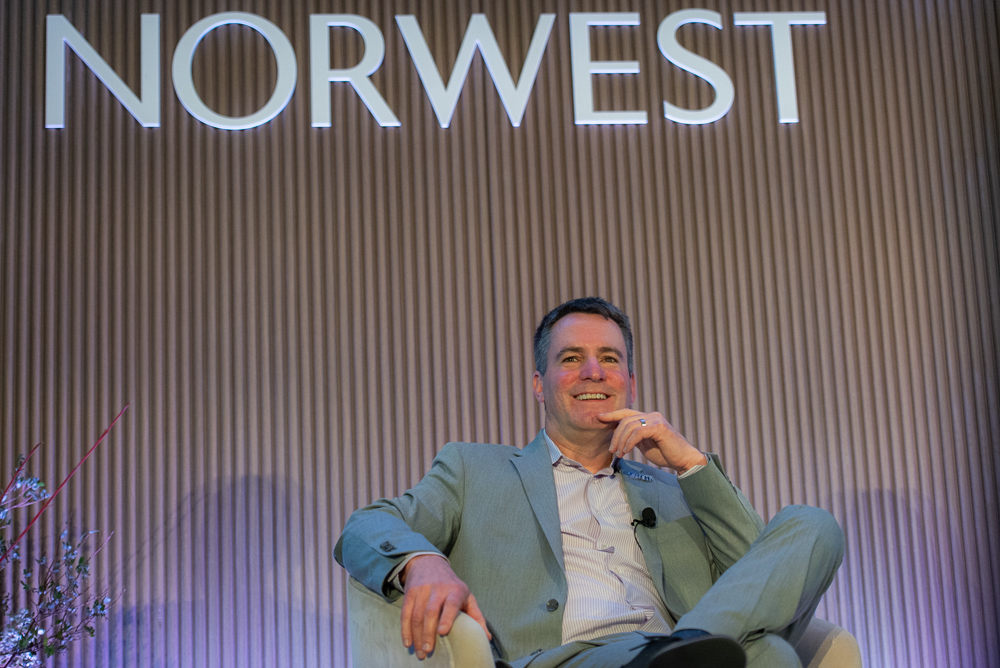
9. Tap Into Partnerships to Help Your Brand Punch Above Its Weight
Give your brand heavyweight status through strategic partnerships. Teaming up with other businesses, organizations, or influencers who align with your brand’s values will amplify its reach and impact. It’s the one-two punch your brand needs to reach new heights.
We were honored to have Talkspace CMO Katelyn Watson and Birdies Co-Founder and President Marisa Sharkey join us and share their insight into leveraging partnerships. Good partnerships are authentic, based on shared values, and tell a story about the brand. As Marisa put it, “There’s no substitute to on-the-ground creativity and pounding the pavement to find new ways to do it.”
Check out Talkspace’s collaboration with Olympian Michael Phelps for inspiration!
10. Confirm Product-Market Fit Before Expanding to More Channels
Before spreading your wings to new channels, make sure your product is winning in its current market. Validate its appeal by listening to your customers and closely tracking their behavior. You can’t build a second story if you have a shaky foundation.
We were joined by two of Ritual’s leaders, President Liz Reifnsyder and VP of Customer Retail Marketing Laura Brodie, who are seasoned experts in omni-channel expansion.
When Ritual first launched it was a DTC, subscription-only company, and the team focused on creating a product that catered to their tribe — the small number of people who loved the brand. They got their feedback and built more reasons for that subset of consumers to love them, which helped them build unparalleled brand trust.
After five years of DTC, the company had achieved $100M in subscription revenue. They knew they’d found their product-market fit in a single channel — and that they could scale that market. They were able to drive adoption, LTV growth and ultimately scale the company into an essentials platform.
Norwest Partner and lead investor in Ritual, Lisa Wu, recently sat down with Ritual founder and CEO Katerina Schneider, to talk more about the company’s brand evolution.
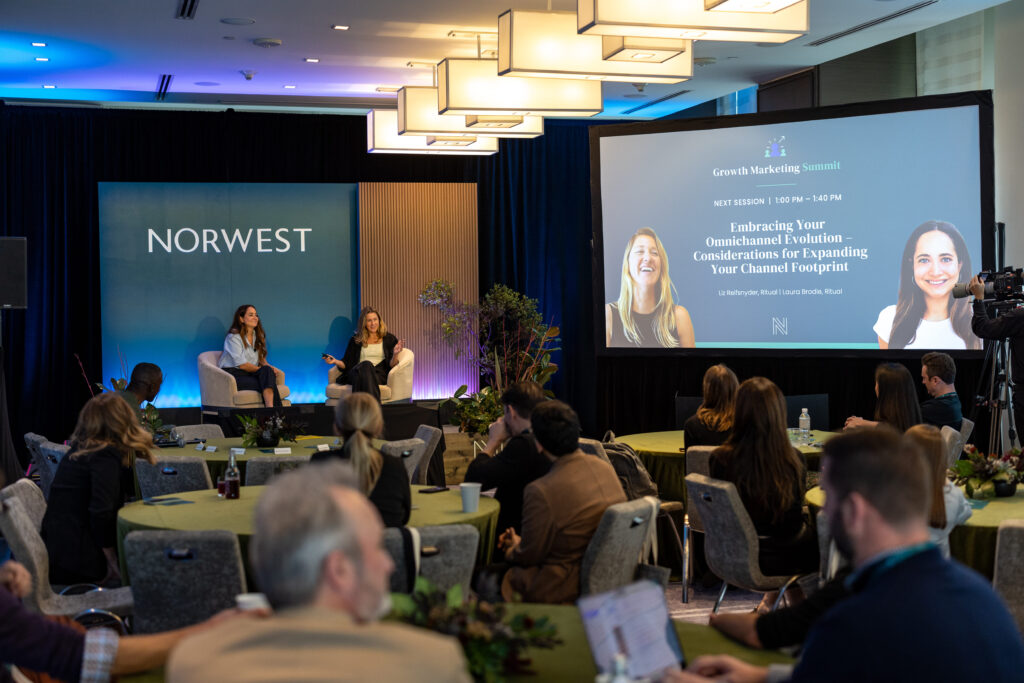
11. Measure Content With Your Heart and Mind
Acknowledge the qualitative impact of content alongside quantitative metrics, recognizing the emotional and brand-building aspects of content creation.
During her session, Babylist Chief Growth Officer Lee Anne Grant shared that the company looks at typical metrics for judging the success of their content, but they try to always look at the full picture of how customers are reacting.
Babylist’s impressive content engine drives commerce, brand, and growth for the company. They’ve built a content flywheel that spans the entirety of their customer journey — and can drive new business and vertical streams. For example, Babylist created a step-by-step guide on getting a free breast pump through insurance that performs well in SEO. That same guide then has played a role in driving business in their newest revenue stream, Babylist Health.
“We wanted to launch a new service that helps women get their breast pump through insurance. Because we had the guide, we could put paid behind it and put it in our emails. The guide now drives about 15% of orders through Babylist Health.”
– Lee Anne Grant, Chief Growth Officer, Babylist
12. Social Shopping and Tele-Shopping Are the Next Big Movement
As the boundaries between entertainment and commerce blur, brands that embrace this trend are well-positioned to tap into a new era of consumer engagement, where seamless, real-time interactions drive the shopping experience.
Two Norwest portfolio companies are heavily leaning into TikTok as an e-commerce platform. Pair Eyewear co-founder and CEO Sophia Edelstein and Wyze’s Head of e-commerce Logan Dunn shared their experiences using TikTok to grow their sales.
Both companies use TikTok, yet in different ways: Wyze uses TikTok Shop and Pair Eyewear does organic posting and TikTok Ads. Both companies also partner with micro influencers to expand their reach. In the last two years, Pair Eyewear has partnered with more than 950 unique influencers, leading to 50-60k new customers that they can attribute to the platform. In a single week, Wyze received 16k orders on TikTok Shop. And, Logan noted, TikTok expects to lose half a billion dollars in order to financially incentive creators to sell through the platform.
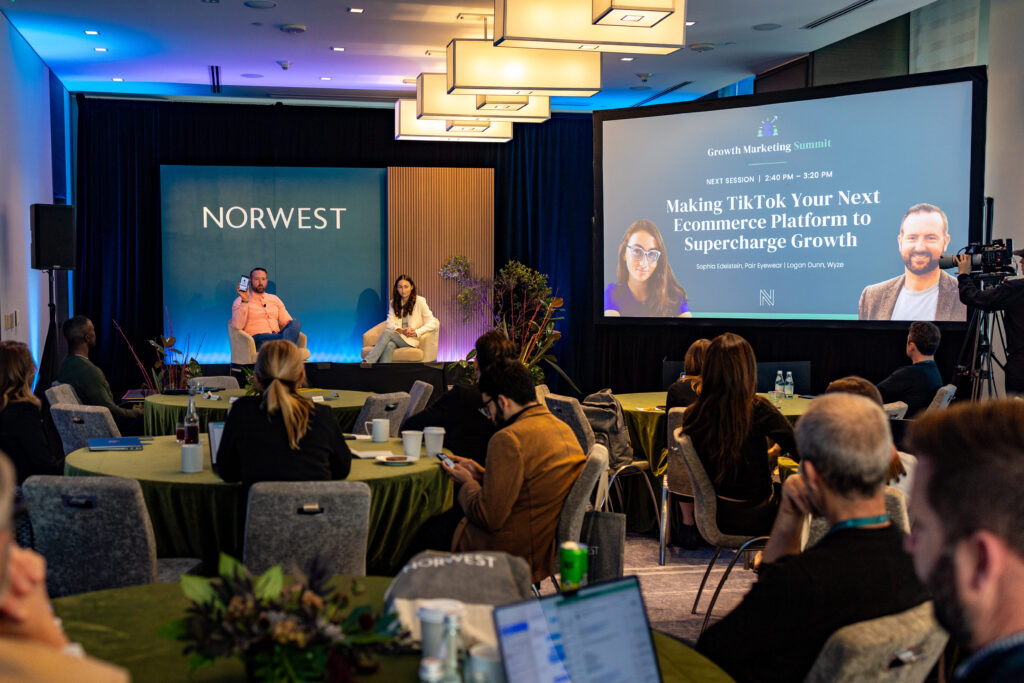
13. Think TV Ads Can’t Be Tracked and Optimized? Think Again.
If you still believe that TV doesn’t have the trackability and optimization benefits of your standard digital marketing channels, you may have fallen prey to some outdated myths. TV has huge potential as a performance marketing channel — and it’s not as expensive as you might think. TvScientific’s VP of Marketing Emily Robinson shared 5 myths about performance TV.
Top myths about Performance TV:
- You need to spend $100k to produce a great TV ad
- Buying a TV ad spot is too expensive to test out
- You can’t buy and optimize TV like your digital channels
- You can’t track or optimize toward outcomes like website visits, sales, ROAs
- It’s too hard to prove the values of performance TV
14. Get to Know Customers As If They’re Your Friends
Treat your customers like cherished friends, not just transactions. Personalize interactions, empathize with their needs, and build relationships that last. A customer-centric approach is the secret sauce for lasting loyalty according to Abodu brand marketing leader Tom Roche.
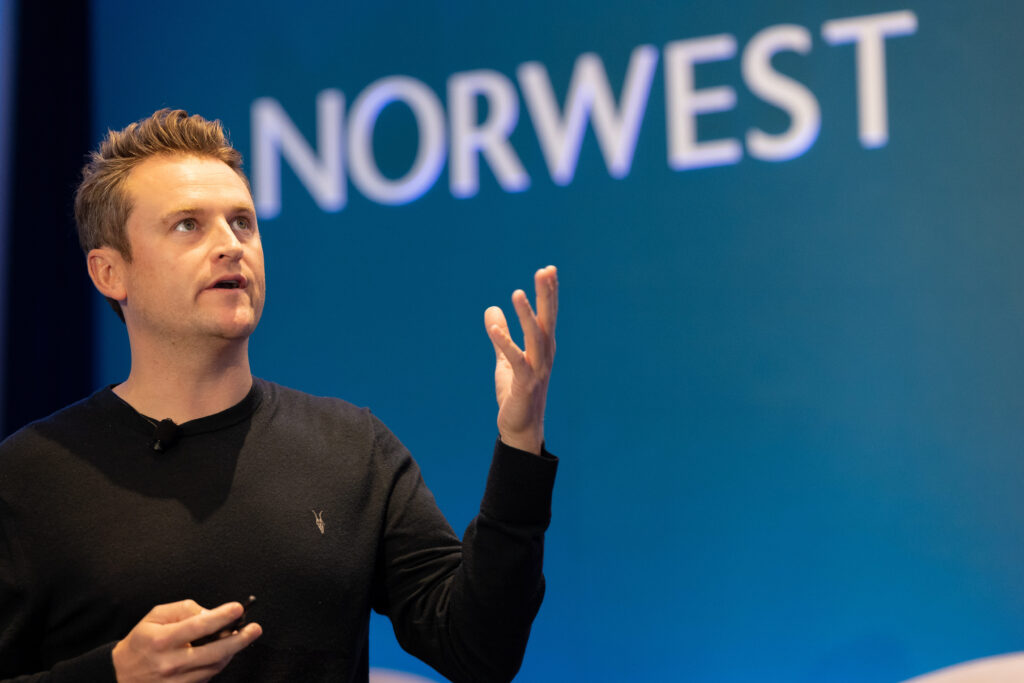
15. Not New, But Worth Repeating: Spending Time With Other Marketers is Priceless
Spending time with other marketers isn’t just networking; it’s a breeding ground for fresh ideas. Heard throughout the day at the Summit: I’m going through the same thing. How did you solve it? That sentiment of shared experience and knowledge exchange is what the Growth Marketing Summit is all about. We brought together marketers across the diverse Norwest marketing community, embracing the rich blend of perspectives from both B2B and B2C spectrums. The convergence allowed each of us to borrow great ideas and principles from each other. It’s an important reminder to be brave and experiment with new channels and tactics, to forge a path towards innovation and growth.
Thank you to all the speakers, attendees, and Norwest team members who made it such a fruitful community event. See you next year!
